A stillness descends on the garden in January. Greenery pulled back to resting buds and all that is necessary to sustain the winter. It used to be that I wanted these weeks to be short, to be reunited with growth again, but increasingly this time feels precious for the opportunity to look at the bones. Quietened and slowed by the season and with all laid bare to see.
The weeks ahead are rarely a downtime and we are seldom plunged into a winter that makes the garden unworkable. Our snow lasts for no more than a few days and frost rarely stays in the ground for long. Winter here is a time for doing, readying and making changes. To be lost in actions and practicalities, with a mind’s eye on the spring. At least, this is how I see it and, at the beginning of January, I make a list of winter work that will take us through to the middle of February. The moment the snowdrops are in full swing, letting me know that the garden will also be stirring. In time to be ready to wade into the beds to remove the remains of the last season and free the resting buds to the air and the lengthening days.
The winter tasks begin with pruning and initiating order now that the leaves are down. When I started my formal training in the 1980’s we began the pruning at leaf drop, to work on the hardiest woodies first and to save the least hardy until the tail end of winter. So apples and pears and wall-trained fruits and climbers were the first point of focus. We paced ourselves and worked towards the roses, leaving them until the end of February to avoid making cuts that could then be burned by a freeze. I remember the winters then being harder and rose wood blackened from cuts made too early, but I have brought this work forward here in Somerset. In the ten years we have been here, we have never had a winter that has damaged the wood and the time I make up early in the year allows time for detailed work before winter tips in to spring. Mulching the parts of the gardens where there are bulbs that are yet to push through and splitting the perennials that stir early in March.
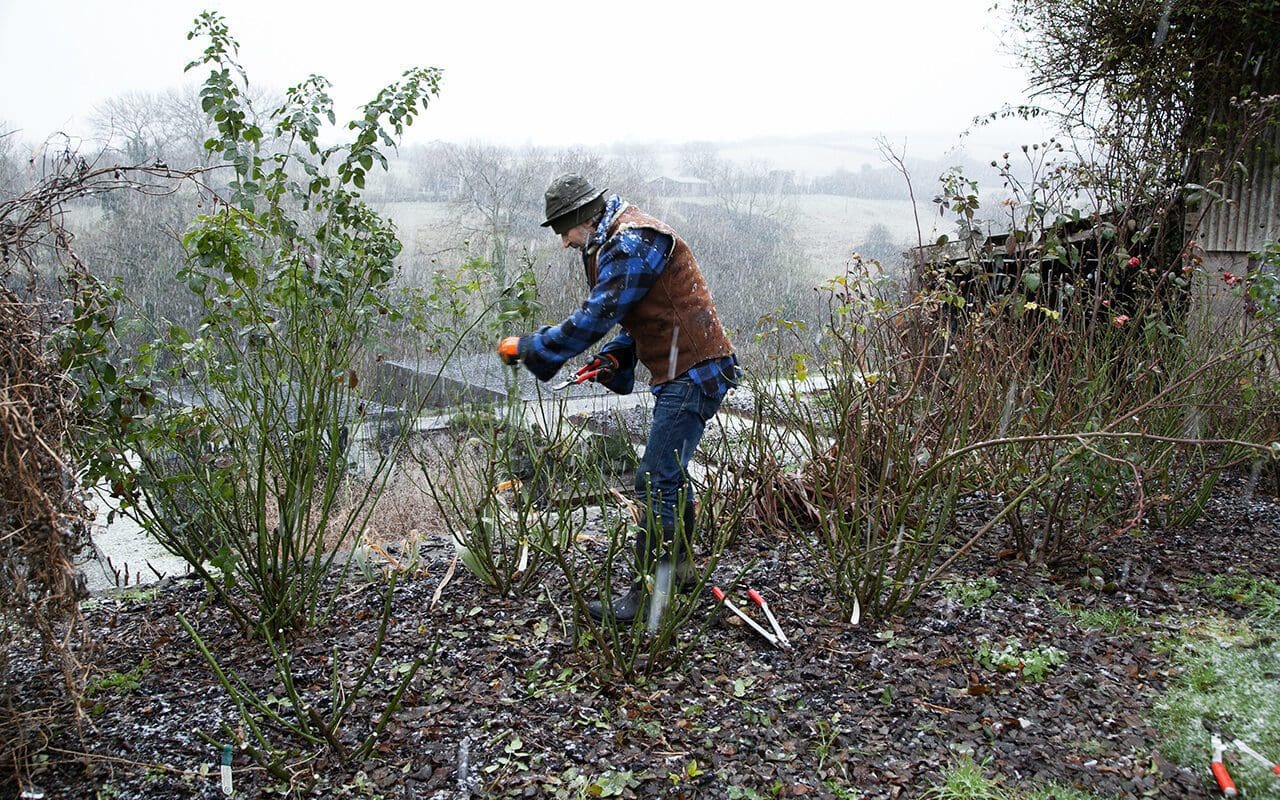
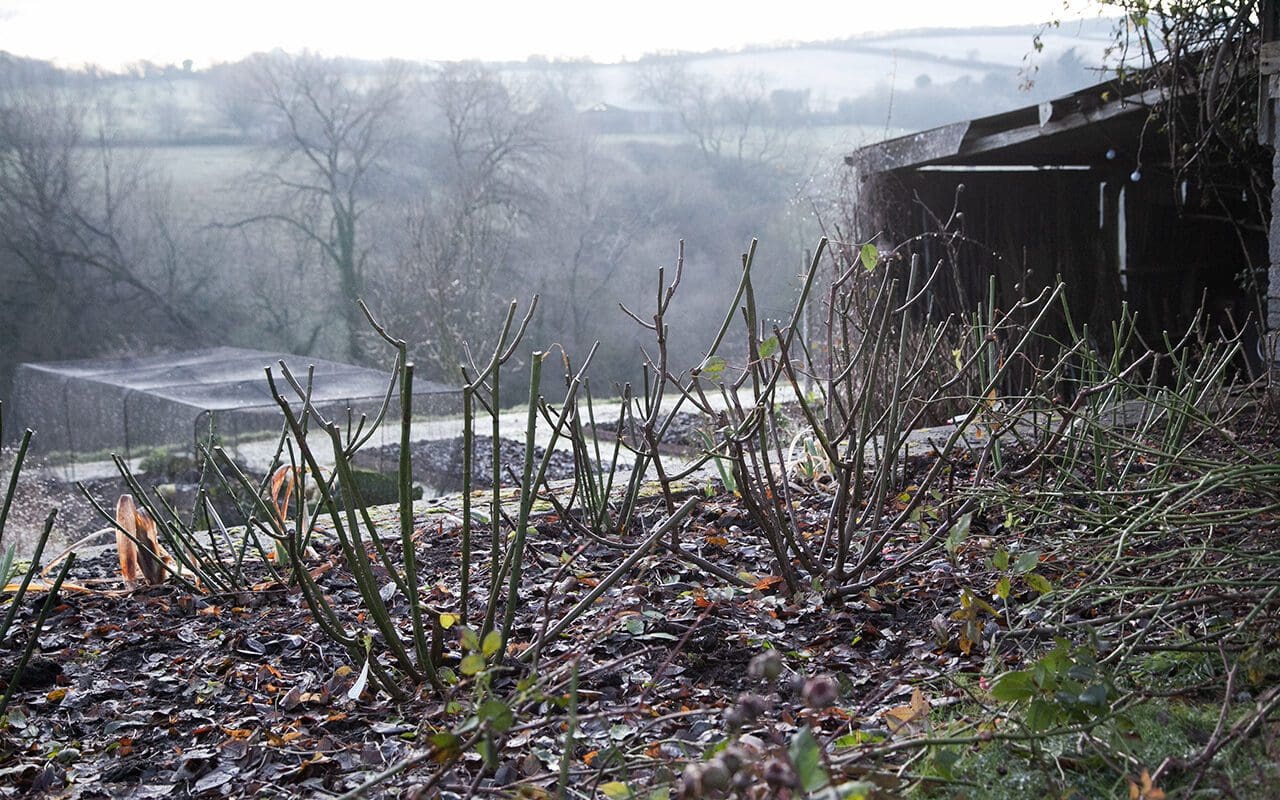
The winter work takes us out into the landscape with tree planting and hedge work and this is a good place to be to retain a clear overview and look back upon the garden. This year, with the help of John, who’s been helping us in the garden since April, we cleared the banks under the hazel at the top of the ditch where the snowdrops were already beginning to nose through the ground in December. They seem to appear earlier every year and I’d made plans to fell a mature hazel that we’d allowed to grow out from a previously broken hedge. There are just a handful of established hazel on the land, but the sixty or so youngsters I’ve planted to make a new coppice should be ready for harvesting by the time we have coppiced the elders.
Hazel responds well to coppicing on an eight to ten year cycle, sending up a fleet of fine young rods that thicken enough to harvest for wood and poles and branch at their reach to make a delicate weave for pea sticks. Wood cut in the first part of the winter retains a pliability that it loses the later it is cut, so the trigger of the snowdrops was useful in setting the winter work into motion in the last fortnight of December.
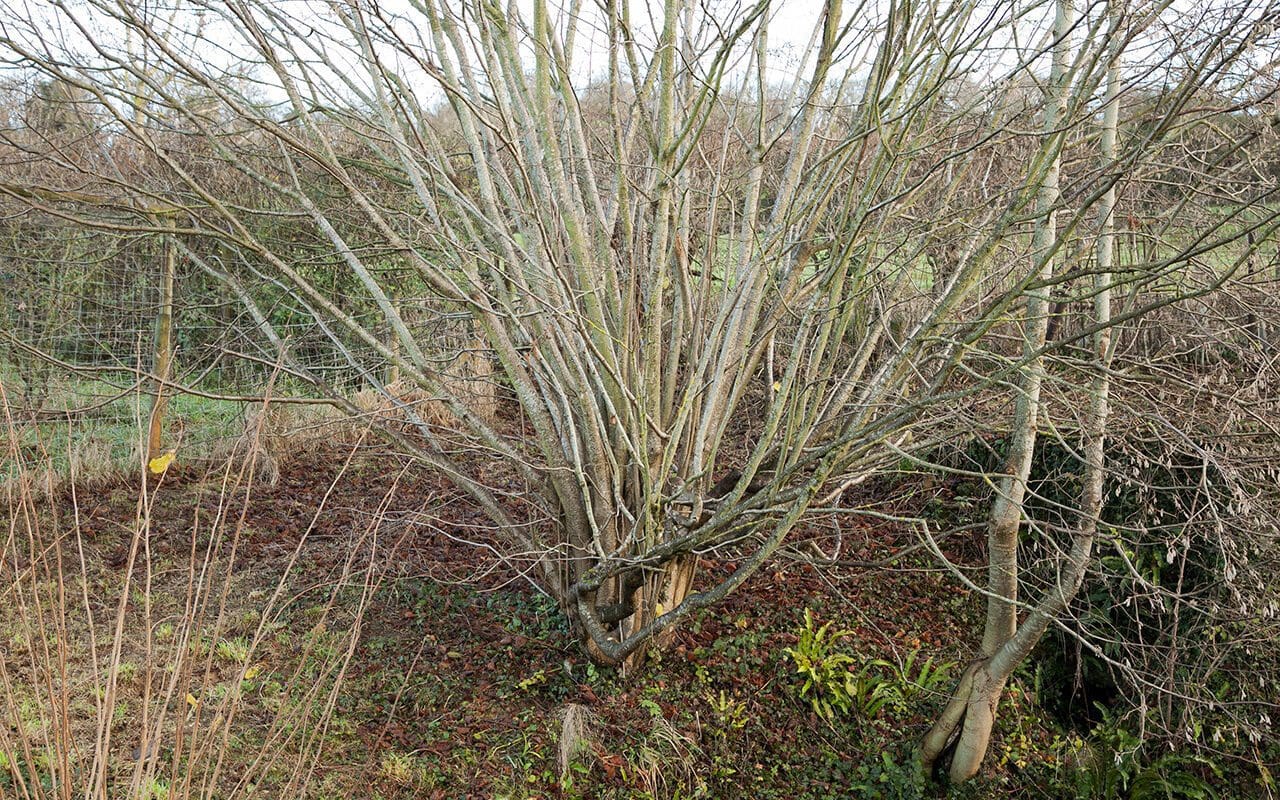
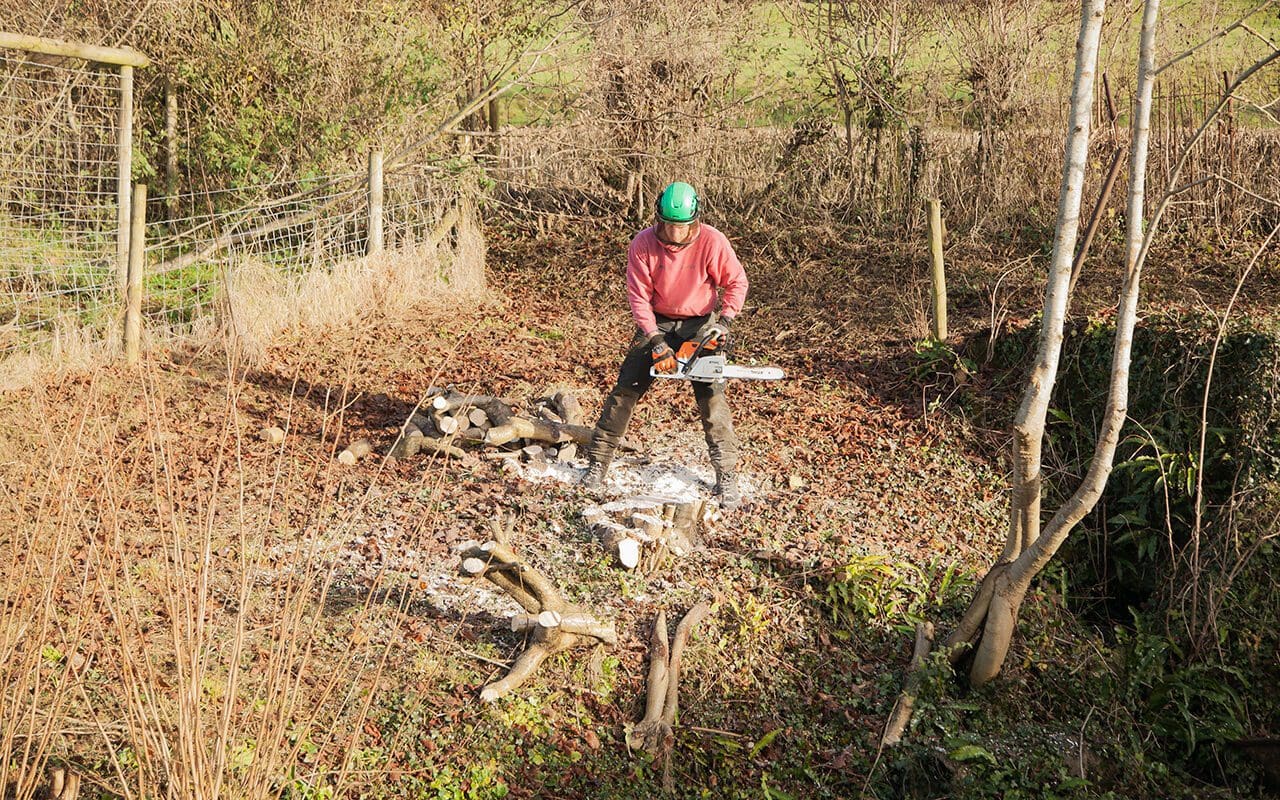
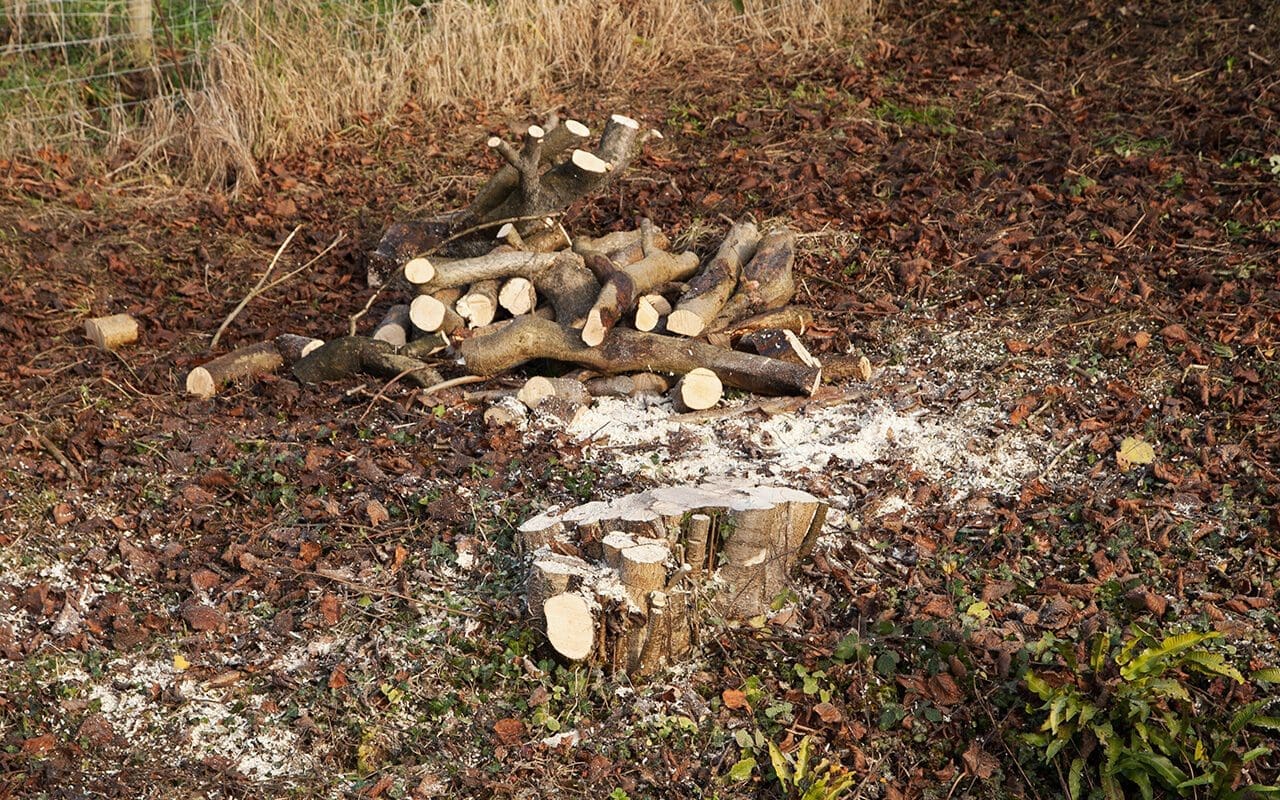
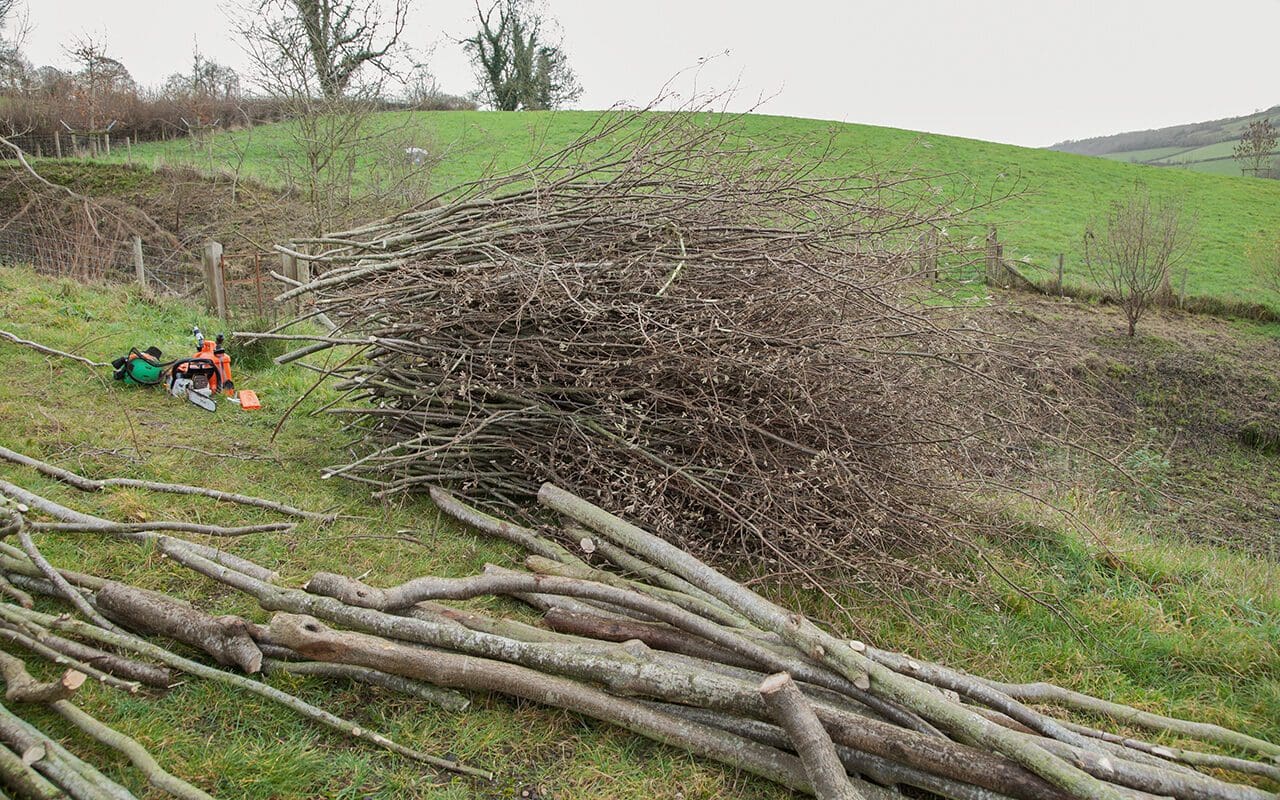
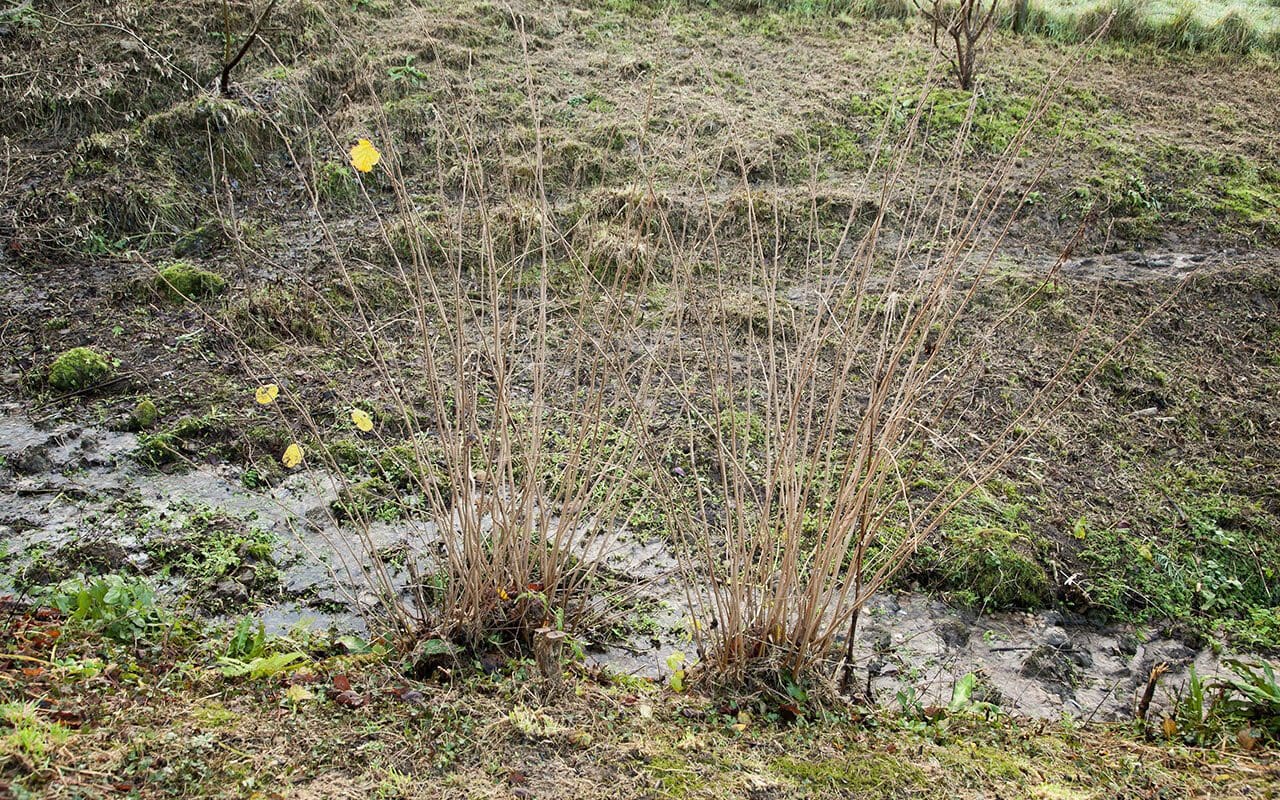
The old coppices I grew up with on the South Downs were well worked land and some of the oldest trees were possibly as much as a thousand years old with the middles of their ancient stools rotted away and the original plant sometimes broken into a family. Coppicing prolongs the life of a tree that responds well to it. Indeed, look at an old hazel that has been left unmanaged and you will often see its limbs leaning like nine pins and snapping at the stump. New growth regenerates from the wound, so management through coppicing simply takes advantage of this nature. The intervention of rotation improves the diversity in the wood, the pool of new light after the fell triggering the ephemerals like foxgloves which by nature live in the halfway place between the wood and the light at the margins.
Here on our banks beneath this recently felled hazel where we have been spreading the primroses about and planting wild daffodils, I expect to see a change these next couple of years. More speedwell, the bulbs basking in spring sunshine to feed their reserves and a proliferation of primrose seedlings that will take this opportunity to extend their reach whilst the going is good. It will not take long – two to three years for the hazel to close over again – and these newly established plants will begin a quieter time in the shadow.
We grade the cuttings, taking the wood for the burner and sectioning the rods for bean poles and the twiggery for pea sticks. The brash is bundled for faggots and a loose weave of unwanted branches is thrown back over the stumps to prevent deer grazing the new shoots in their first important year of ascending upwardly out of harm’s way. It is a process that we are happy to initiate and be part of as the year turns. One of renewal and hope and usefulness. A fine way to start a year that will not be without its challenges.
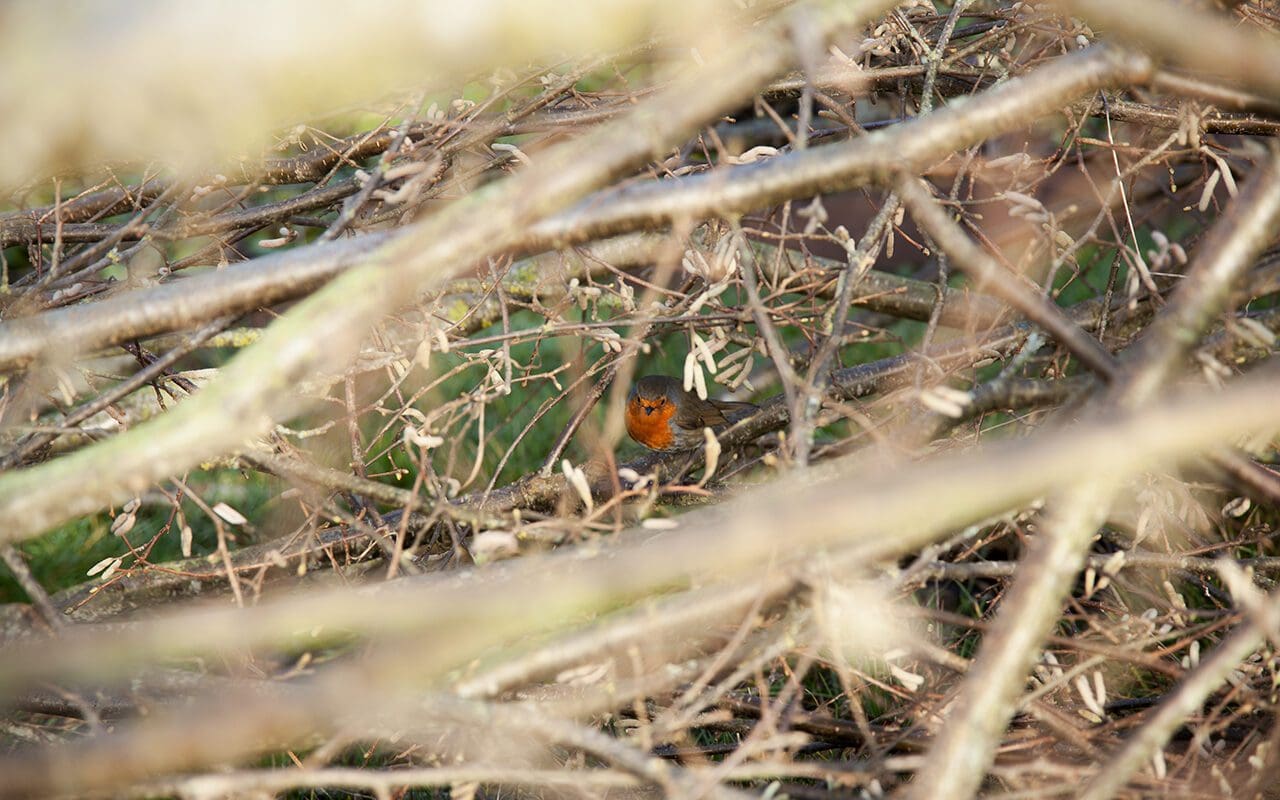
Words: Dan Pearson | Photographs: Huw Morgan
Published 9 January 2021
We have half a dozen mature hazels (Corylus avellana) that survived here for being out of reach of the grazing. They cling to the banks of the brook opposite our neighbour’s wood and were protected by a run of barbed wire that kept the cattle from the brook’s edge and, in turn, provided the trees with their own little sanctuary. Their domain, very sensibly, was over the water and into the shade, but it is remarkable how quickly a change of regime is marked in growth and, in the eight years without the cattle, their limbs have reached back over our land so that that you now have to duck as you approach. In their shadow I have been planting snowdrops, which like the moisture there in the winter and the drier influence of their roots in the summer.
The pools of catkin and snowdrop have made new places that we are drawn to explore when the winter is with us. Look down now on the wood from our perch on the hillside and the pale golden cast of the catkins reveal where the hazels run. Happy to live in the understory of the tall poplars above them, their rangy limbs topple like collapsed scaffolding where they have gone without coppicing, but you can read their preference for the hinterland. At the edges of the wood and where they step out from the high canopy and finger up the brook in the open crease at the bottom of the slopes, they look most contented. The billowing outline of one tree running into another reveals their true character and shows you where they thrive. Huddled on the edge of the wood where it is still and moist and sheltered.

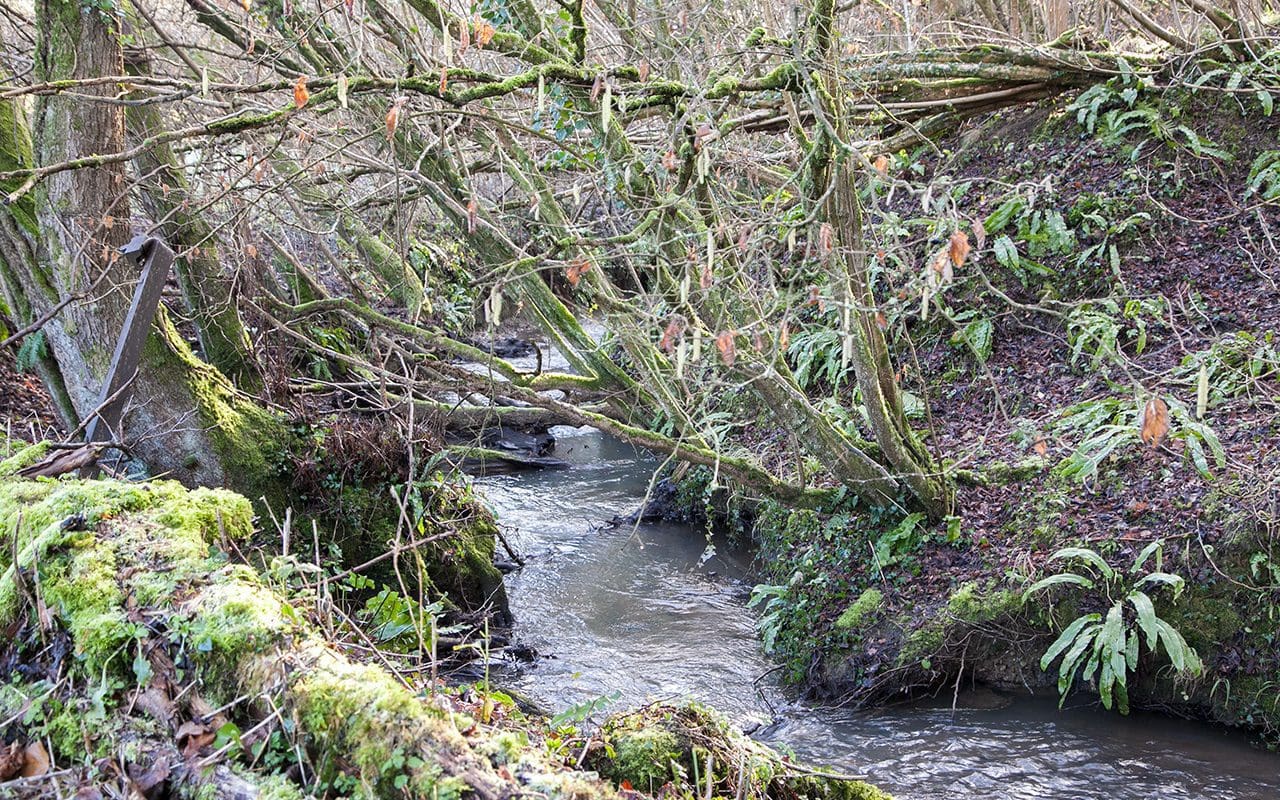
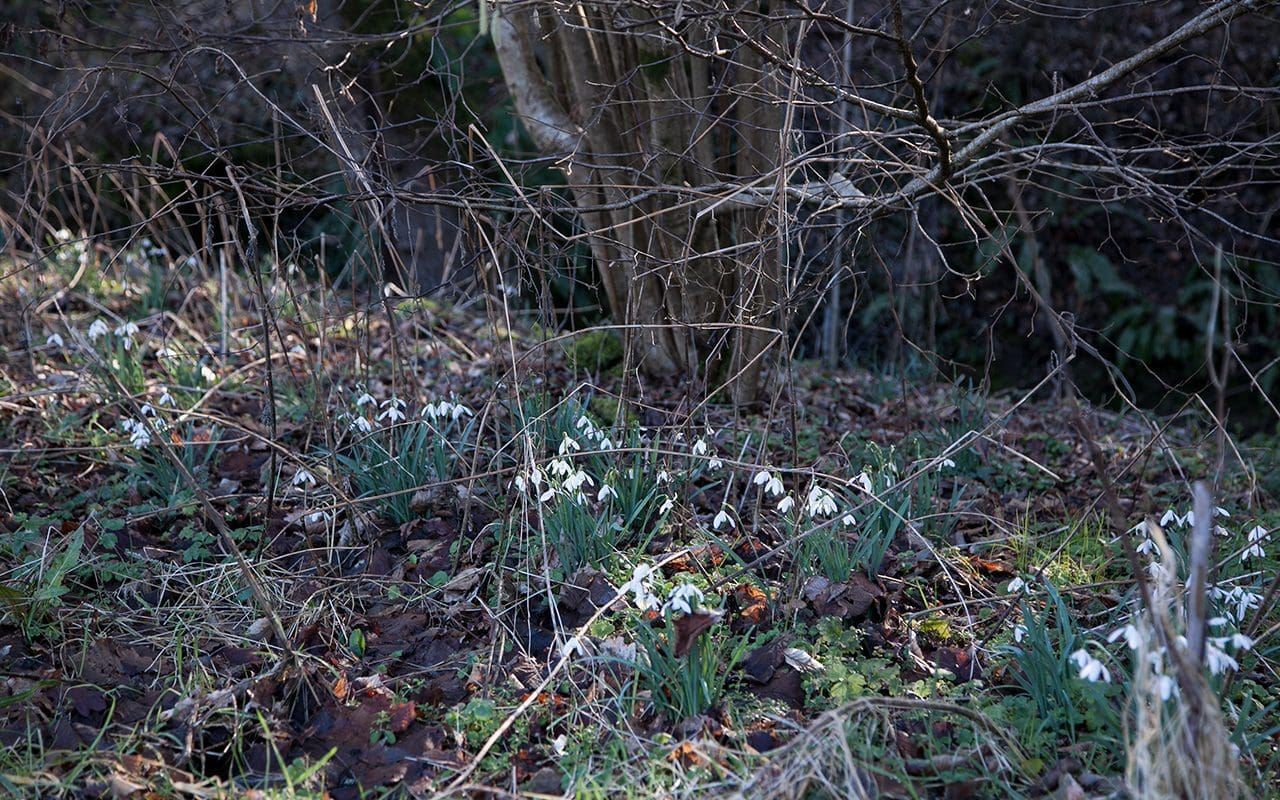
Walk the line of the hedges up the slope away from the wood and you find hazel here too. Nuts that were buried by squirrels and forgotten, but happy to be part of the hedgerow and its community. It is impossible to tell the age of the hazels that sit in the hedge, for they will take a regular cut and regenerate as a shrub rather than a tree, but they are probably as old as their cousins in the wood. Further up the hill again, where some of the hedges along the ditch were nothing more than a twist of barbed wire and bramble, it is often the hazel that has outlived its neighbours. By disentangling the wire from the bushes that had been habitually scalped by the flail and then kept in check by the cattle, a number have been freed and left to regenerate. Although you can see the previous brutal regime in their eldest limbs, they have shot from the base as hazels do and, in just eight years, we have the beginnings of a new grove.
Where I come from on the South Downs, the ancient coppices contain trees that are thought to be as much as a thousand years old. The original stumps have rotted away from the middle, but you can see the oldest plants in the coppice mapped in the close groupings of offsets that have radiated outward over time. New trees that have been deliberately layered (that is, rooted by bending the longest shoots to the ground and weighting them with a stone) stand at a sensible distance of about eight strides to give them room enough, but still with the company they need to draw new growth up and straight towards the light.
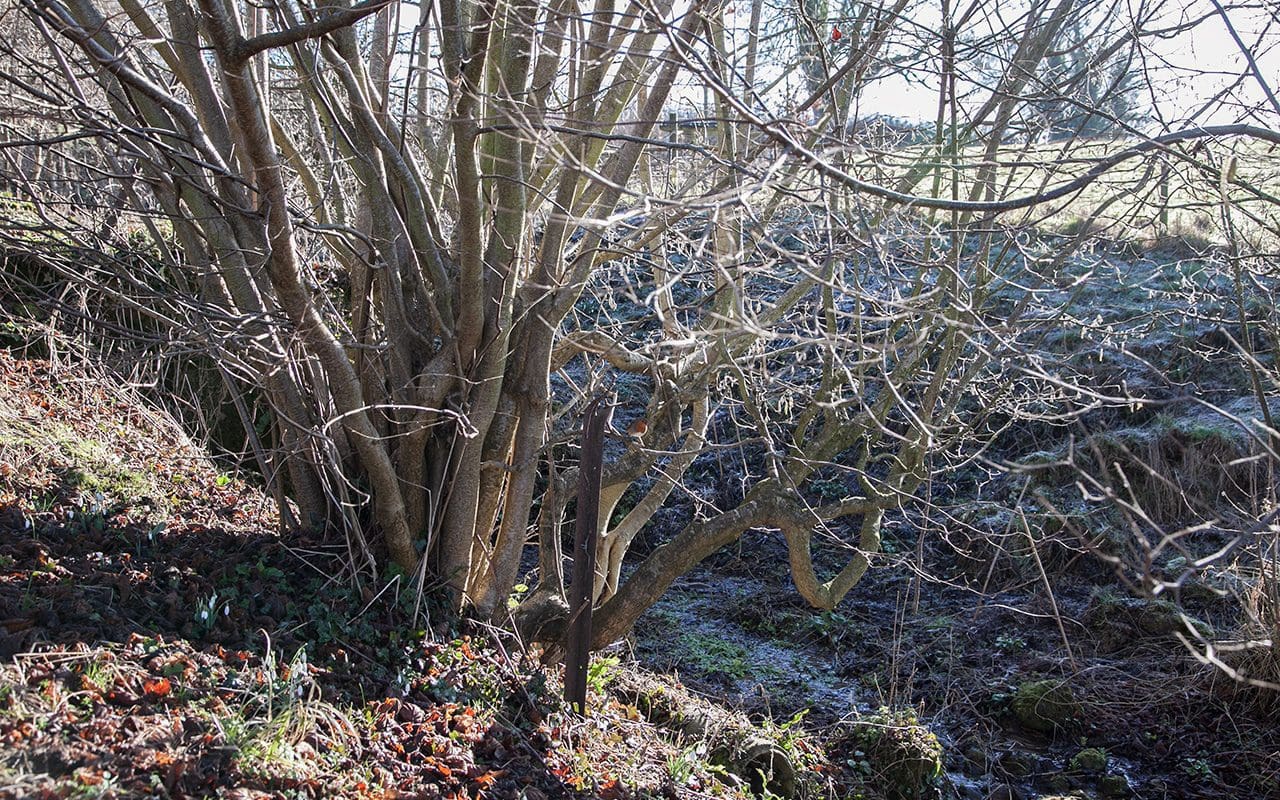

Coppicing extends the life of a tree and the industry around it traces our woodland symbiosis in a long and unbroken line of charcoal production as well as material for hurdles, furniture and building. Cut on an eight to twelve year rotation, a hazel coppice will regenerate fast, the trees touching again in four or five years, but not before a valuable interlude of light has been allowed to reach the woodland floor. Ephemeral woodlanders such as foxgloves seize this window of opportunity and bluebells, wood anemone and primroses take the chance to build up their strength before being cast once again into more permanent shade.
The best material from coppicing, which retains its pliability, is cut at the beginning of the winter. Later cuts between January and March produce wood that is prone to brittleness. The finer top growth is used for pea sticks, faggots and withies. The rods, which can run straight to four metres, are either split and used for hurdle making and building materials or, in my case, for plant supports in the kitchen garden. A twelve year rotation will also produce firewood. The brash and less useful brush is piled or woven over the coppiced stump to prevent the deer from nibbling the regenerating shoots. A year will see new growth push clear of the grazing line before the brash has rotted and returned to the ground.
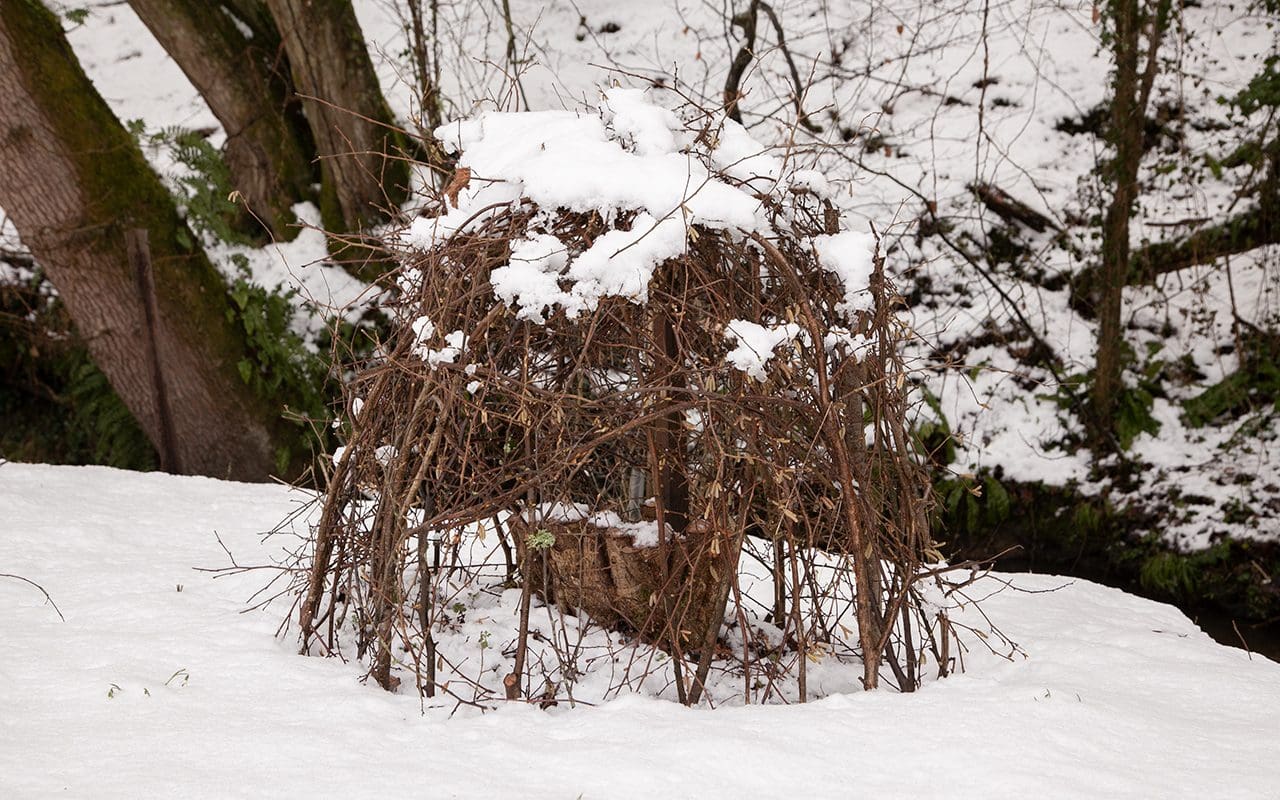
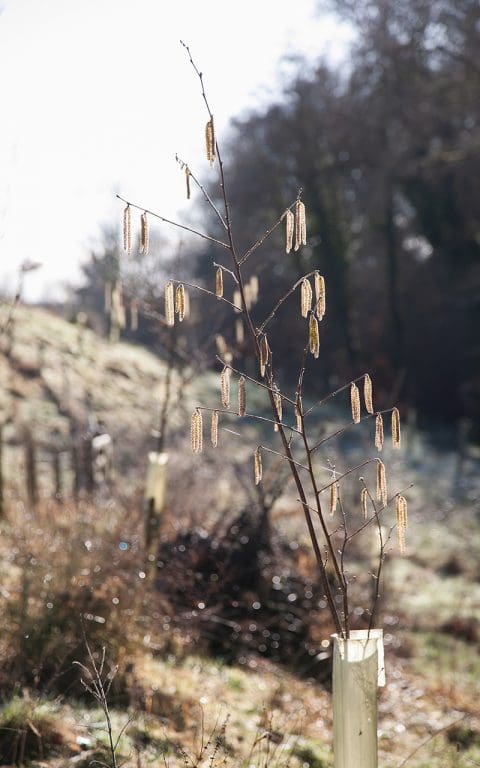
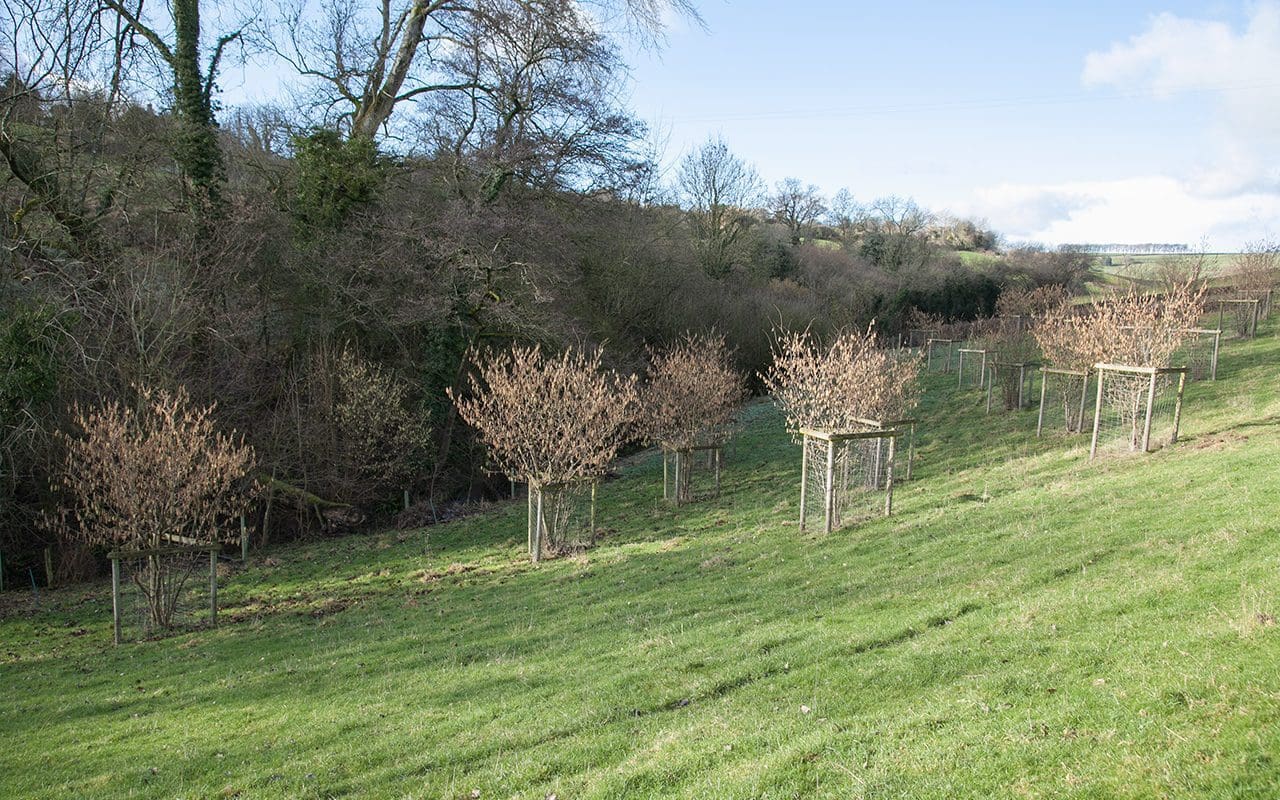
In the second winter here, having seen where the wild trees were happiest, I planted a grove of filberts and cobs below the new orchard. Cobs are Corylus avellana selections, filberts Corylus maxima. Though very similar in appearance to the native hazel, they are chosen for their superior nuts and are distinctive for their crested outer calyx. There are twenty one trees, three of each of seven varieties; ‘Webb’s Prize’, ‘Gunslebert’, ‘Kentish Cob’, ‘Cosford Cob’, ‘White Filbert’, ‘Butler’ and, naturally, ‘Pearson’s Prolific’. Though to date the squirrels have stripped them just days before we consider them ripe enough for our own consumption, we remain hopeful that in time we will get enough nuts to go round.
Staggered in an informal grid of eight metre spacing, the trees sit in grass and take the formality of the orchard down to meet the wood. For now they are protected with tree guards, so that I can let the sheep graze amongst them, but in time, when the canopy closes over, I will fence the nuttery in and bring the woodland floor into this area. Further downstream, a new informal coppice of straight hazel is set to join the mature trees that run the length of the stream. In five years’ time I am hoping they will be big enough to coppice. A cycle which may be repeated many times in the life of these young trees. Only a handful of times by me, but hopefully many more with their legacy.
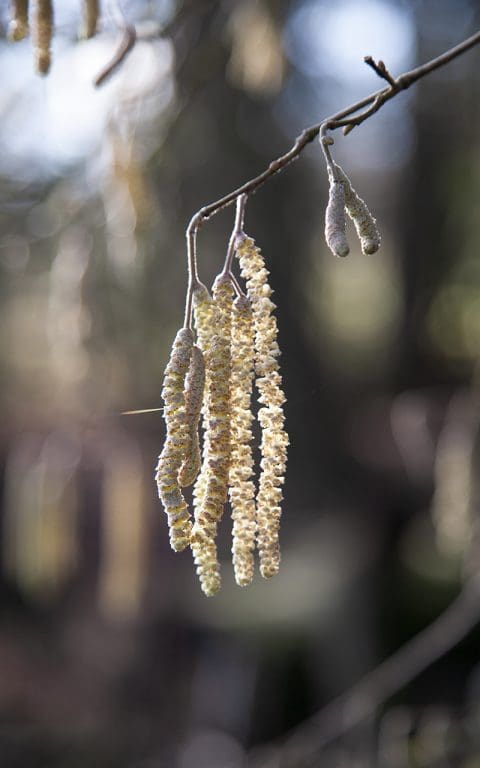
Words: Dan Pearson/Photographs: Huw Morgan
Published 2 February 2019
The farmer here before us had grazed the land hard with the precious pasture or ‘grub’ taking precedence over the trees. Our neighbour has shown us photos of the valley when she was a girl, unrecognisable for the majestic elms in every hedge. When the elms came down during the 1960’s and ’70’s, their demise opened up the landscape and, save a handful of mature ash that run along the lane, the hedges have remained low and uninterrupted. On his last winter here, the year before we took over the land in 2010, the farmer scaled the solitary ash that stands proud on the slopes of The Tump and pollarded it back to its torso. The ancient pollards are a feature of the valley, for ash (Fraxinus excelsior) burns green and so is a valuable wood for winter fires. Our limbless pollard stood starkly that first November, just a small amount of regrowth marking the time the property had taken to come into our hands. Representing, as it did, the end of an era and the start of a new chapter, we immediately marked about thirty hedgerow ash so that, when the hedges were cut, they would be left to rise up and away to become new hedge trees. Though not a brilliant hedging plant, ash in a hedge are more than happy to take a yearly cut and, with the advantage of being already established in the hedge, they have raced away. In that first winter I planted another thirty ash whips that were winkled in where gaps opened up after removing elder and bramble. The young whips have to be watched for the first three years as they have competition for light and water from the hedge to either side, but as soon as they were tall enough I tied a ribbon to their leader so that the farmer who cuts our hedges can work around them.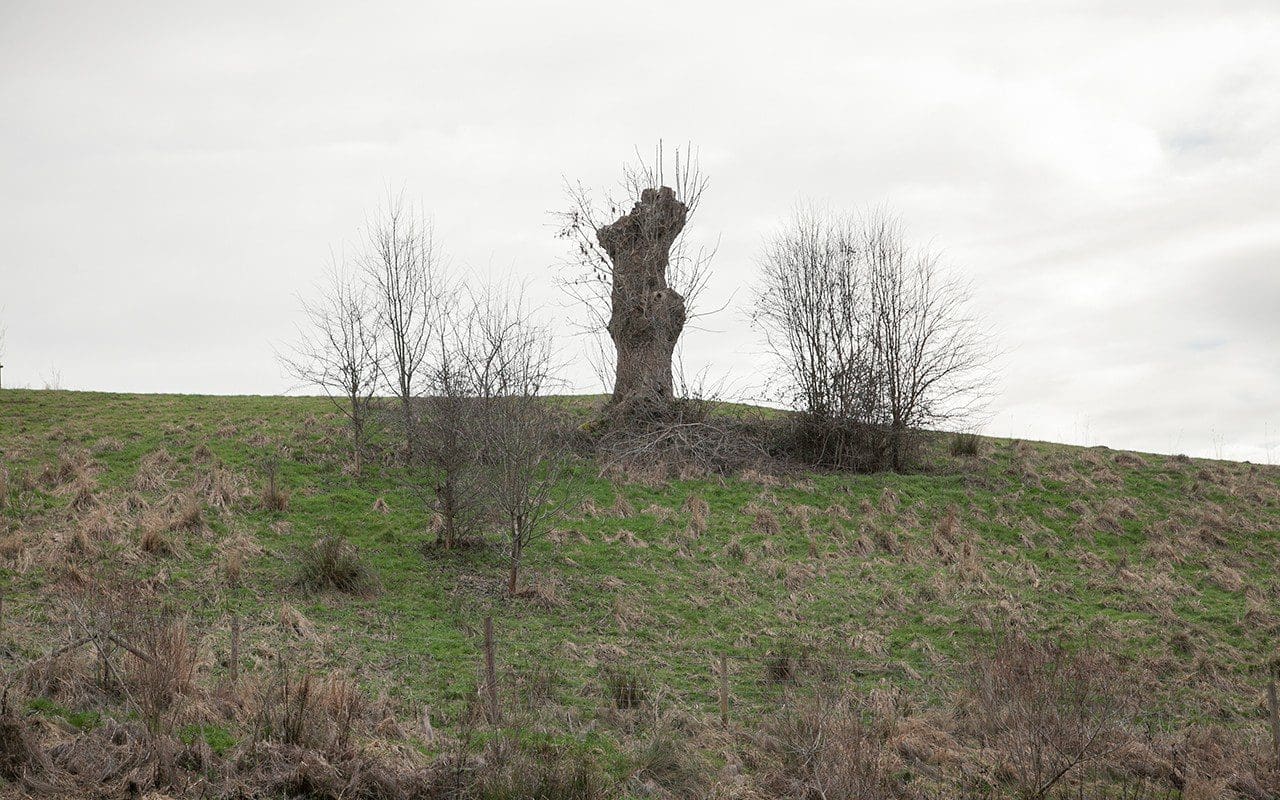 The old ash pollard on The Tump has now been joined by a number of self-seeded hawthorns
The old ash pollard on The Tump has now been joined by a number of self-seeded hawthorns
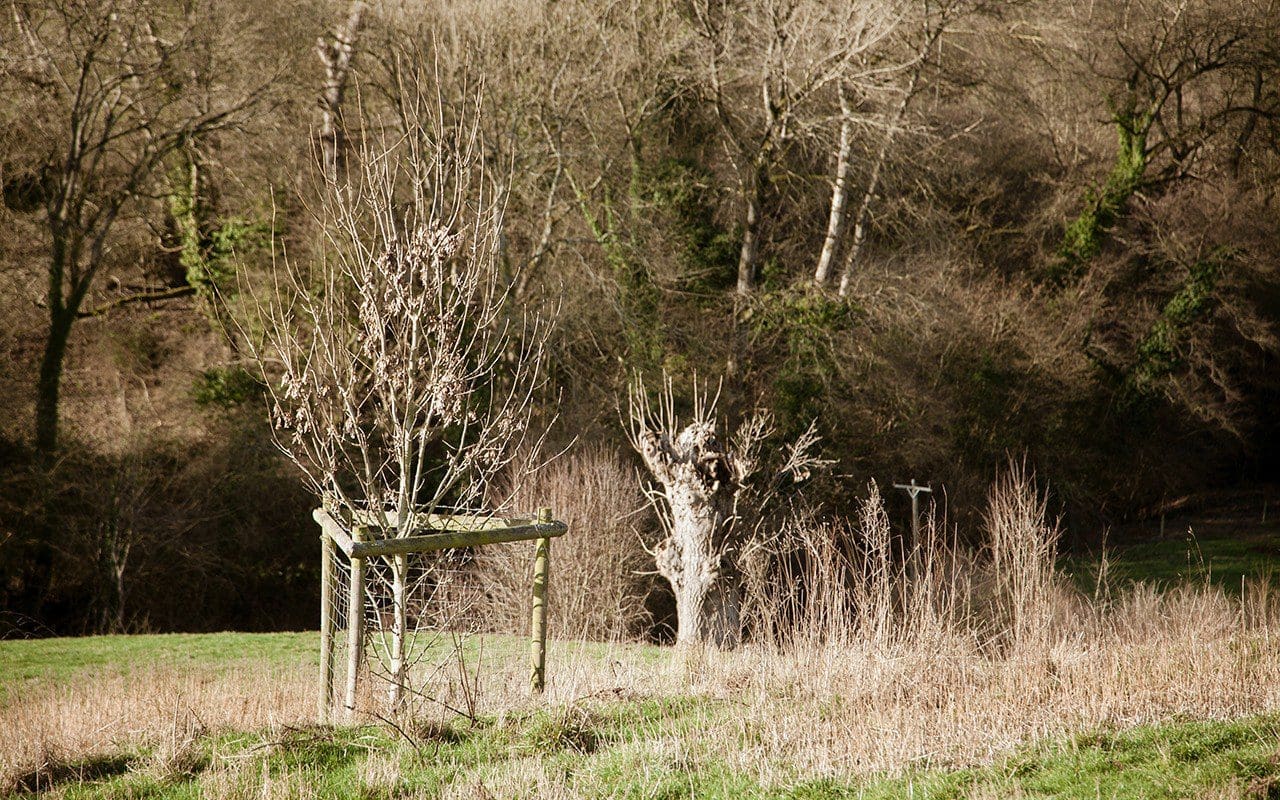 One of the ash planted eight years ago on the slopes above the old pollard, the top of which can be seen in the background
One of the ash planted eight years ago on the slopes above the old pollard, the top of which can be seen in the background
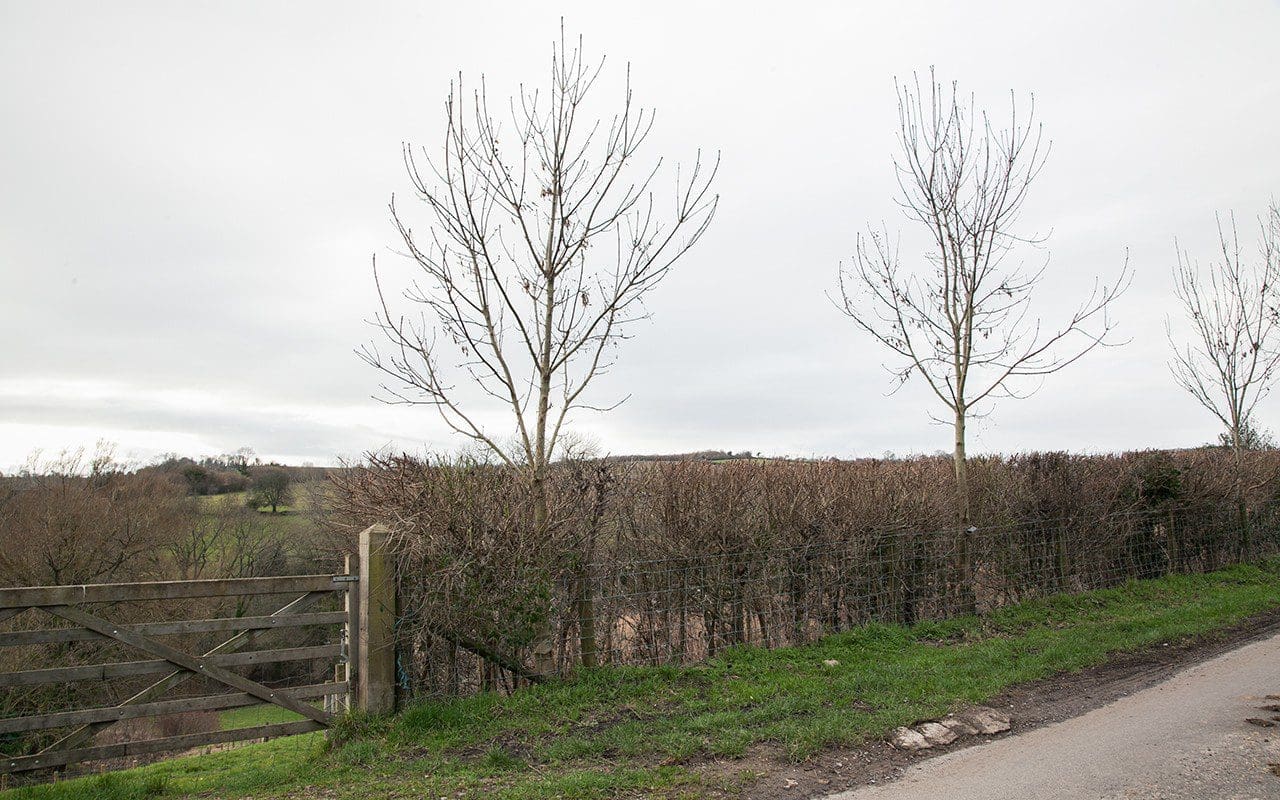 Three of the ash planted eight years ago into the hedge on the lane
It was a good plan, or so I thought, to have my hedge trees on a ten year rotation and pollard enough every year to fuel our wood burners. The spectre of ash dieback was first confirmed in the UK just two years later in 2012 and it is now sobering to think how quickly things can change. We discovered the first signs in some seedling trees about three years later and, although none of the trees I planted have been affected yet, my own plans of ash pollards are now in question. And then, as with the disappearance of the elms, there is the visual change we will inevitably see in the landscape, since ash is such a key and widespread component of our woodlands.
The initial panic that circulated in the press soon after the discovery of Chalara eased a little while we waited to see what happened. However, caused as it is by a fungus with wind-borne spores, it has taken only 6 years to become widespread and is now present in most of the country, bar the north of Scotland. What has become clear is that, once a tree is infected, the disease is usually fatal. However, mature trees can survive for some time and during that time they continue to make a valuable contribution to the local ecology and landscape. Ash are also profligate with their seed and scientific study into variability has already shown that a small number of trees are able to tolerate or resist infection.
Hopefully the strong will win out and, with that belief, my plans seem not entirely without hope. But what is becoming increasingly clear is that diversity is important and that no one environment should have all its eggs in the same basket. With this in mind, I have been widening my net and, every year since we came, I have made it a mission to broaden the palette of native trees on the land. There are several projects on the go and winter work includes hedge improvement and extension and the finding of places for long-termers that can step into the fields without making them difficult to manage with machinery.
Three of the ash planted eight years ago into the hedge on the lane
It was a good plan, or so I thought, to have my hedge trees on a ten year rotation and pollard enough every year to fuel our wood burners. The spectre of ash dieback was first confirmed in the UK just two years later in 2012 and it is now sobering to think how quickly things can change. We discovered the first signs in some seedling trees about three years later and, although none of the trees I planted have been affected yet, my own plans of ash pollards are now in question. And then, as with the disappearance of the elms, there is the visual change we will inevitably see in the landscape, since ash is such a key and widespread component of our woodlands.
The initial panic that circulated in the press soon after the discovery of Chalara eased a little while we waited to see what happened. However, caused as it is by a fungus with wind-borne spores, it has taken only 6 years to become widespread and is now present in most of the country, bar the north of Scotland. What has become clear is that, once a tree is infected, the disease is usually fatal. However, mature trees can survive for some time and during that time they continue to make a valuable contribution to the local ecology and landscape. Ash are also profligate with their seed and scientific study into variability has already shown that a small number of trees are able to tolerate or resist infection.
Hopefully the strong will win out and, with that belief, my plans seem not entirely without hope. But what is becoming increasingly clear is that diversity is important and that no one environment should have all its eggs in the same basket. With this in mind, I have been widening my net and, every year since we came, I have made it a mission to broaden the palette of native trees on the land. There are several projects on the go and winter work includes hedge improvement and extension and the finding of places for long-termers that can step into the fields without making them difficult to manage with machinery.
 A newly planted oak has a temporary tree guard
A newly planted oak has a temporary tree guard
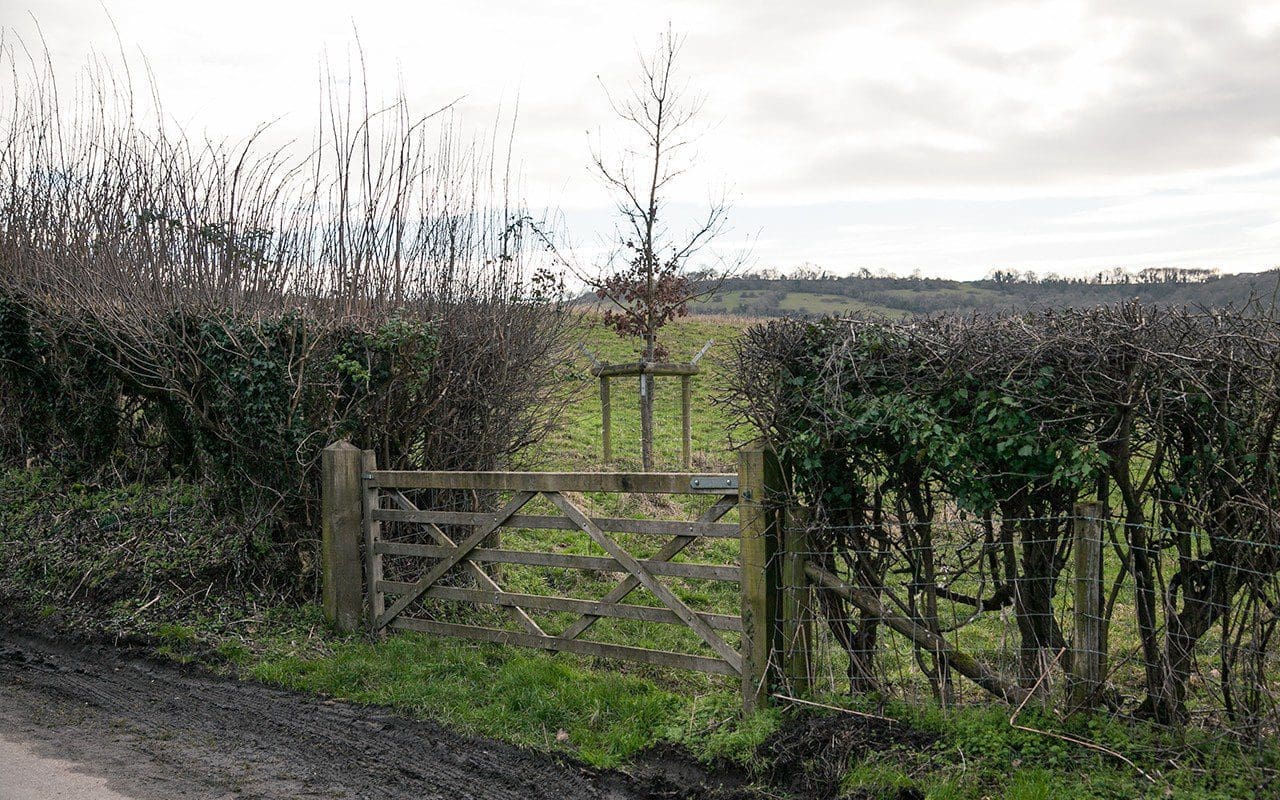 A gate marker oak planted 4 years ago
Every year I have planted a handful of English oaks (Quercus robur), using them as markers by gates (main image, the large trees are ash) so that you can both locate the breaks in the hedges from a distance and to make a place of the gate; a place to stop in the shade or somewhere for the animals to gather in the heat of the day. Although with climate change there is some speculation as to the long-term suitability of oak in Southern England, my hope is that the combination of our hearty soil and the spring lines that run through the slopes will give them their best chance. Oak has the highest biodiversity count of all native trees and so I am also planning for the life that comes with them.
As gaps have opened up as I upgrade our old hedgelines by stripping them of dominant runs of bramble, elder and old man’s beard, I have been adding common lime to replace the ash should they fail as hedge trees. Tilia x europaea is a beautiful tree if you have the room, not just for its vibrant leaf colour, but for the perfume of the flowers and the benefit these have for the bees and us, as it comes in quantity and makes a delicious tea. Once again, the trees will need extra care and, with this in mind, I made sure they were all planted before the end of the year so that their hair roots can get the best possible chance of being in contact with the soil before the spring. The trees were also given a good mulch of compost to hold in the moisture.
A gate marker oak planted 4 years ago
Every year I have planted a handful of English oaks (Quercus robur), using them as markers by gates (main image, the large trees are ash) so that you can both locate the breaks in the hedges from a distance and to make a place of the gate; a place to stop in the shade or somewhere for the animals to gather in the heat of the day. Although with climate change there is some speculation as to the long-term suitability of oak in Southern England, my hope is that the combination of our hearty soil and the spring lines that run through the slopes will give them their best chance. Oak has the highest biodiversity count of all native trees and so I am also planning for the life that comes with them.
As gaps have opened up as I upgrade our old hedgelines by stripping them of dominant runs of bramble, elder and old man’s beard, I have been adding common lime to replace the ash should they fail as hedge trees. Tilia x europaea is a beautiful tree if you have the room, not just for its vibrant leaf colour, but for the perfume of the flowers and the benefit these have for the bees and us, as it comes in quantity and makes a delicious tea. Once again, the trees will need extra care and, with this in mind, I made sure they were all planted before the end of the year so that their hair roots can get the best possible chance of being in contact with the soil before the spring. The trees were also given a good mulch of compost to hold in the moisture.
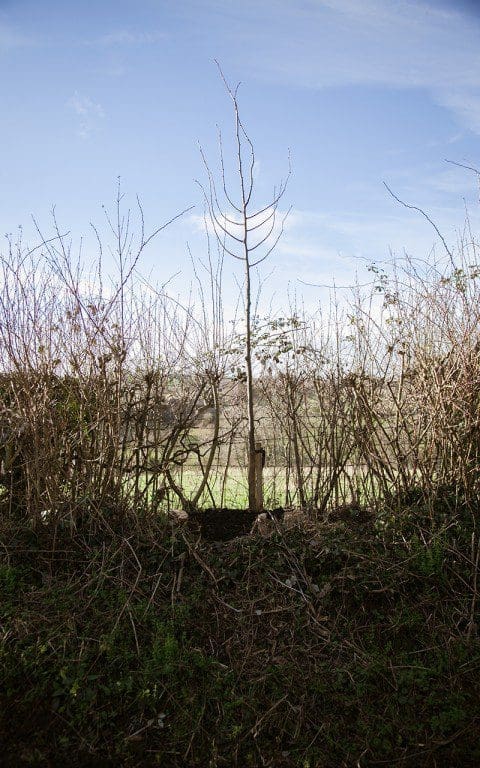 One of the new limes planted as hedge trees
Hedge trees are space efficient and their presence along the lanes as another storey above the hedgeline produces protected microclimates and a stillness that harbours insects. The bats run through these fertile air pockets, using them as feeding corridors, as do the birds that benefit from cover from predators. When we first arrived here one of the first things we noticed was the lack of birdlife near the house, with no trees and scalped hedges. We have quickly seen them return, as the trees have risen up to provide shelter, shade and perches for chatter or prey-watching.
One of the new limes planted as hedge trees
Hedge trees are space efficient and their presence along the lanes as another storey above the hedgeline produces protected microclimates and a stillness that harbours insects. The bats run through these fertile air pockets, using them as feeding corridors, as do the birds that benefit from cover from predators. When we first arrived here one of the first things we noticed was the lack of birdlife near the house, with no trees and scalped hedges. We have quickly seen them return, as the trees have risen up to provide shelter, shade and perches for chatter or prey-watching.
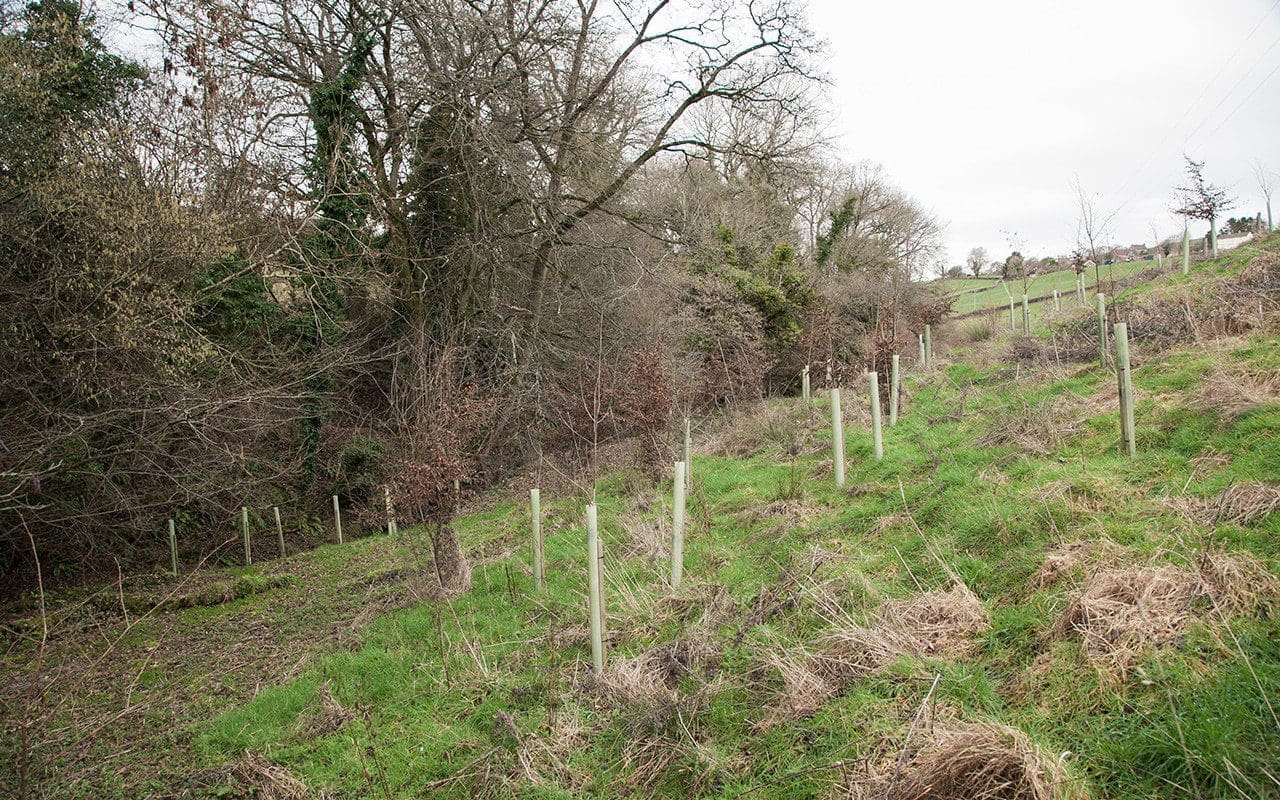 Part of the area of hornbeam and hazel coppice on the lower slopes of The Tump above the stream, which were planted 4 and 5 years ago
Part of the area of hornbeam and hazel coppice on the lower slopes of The Tump above the stream, which were planted 4 and 5 years ago
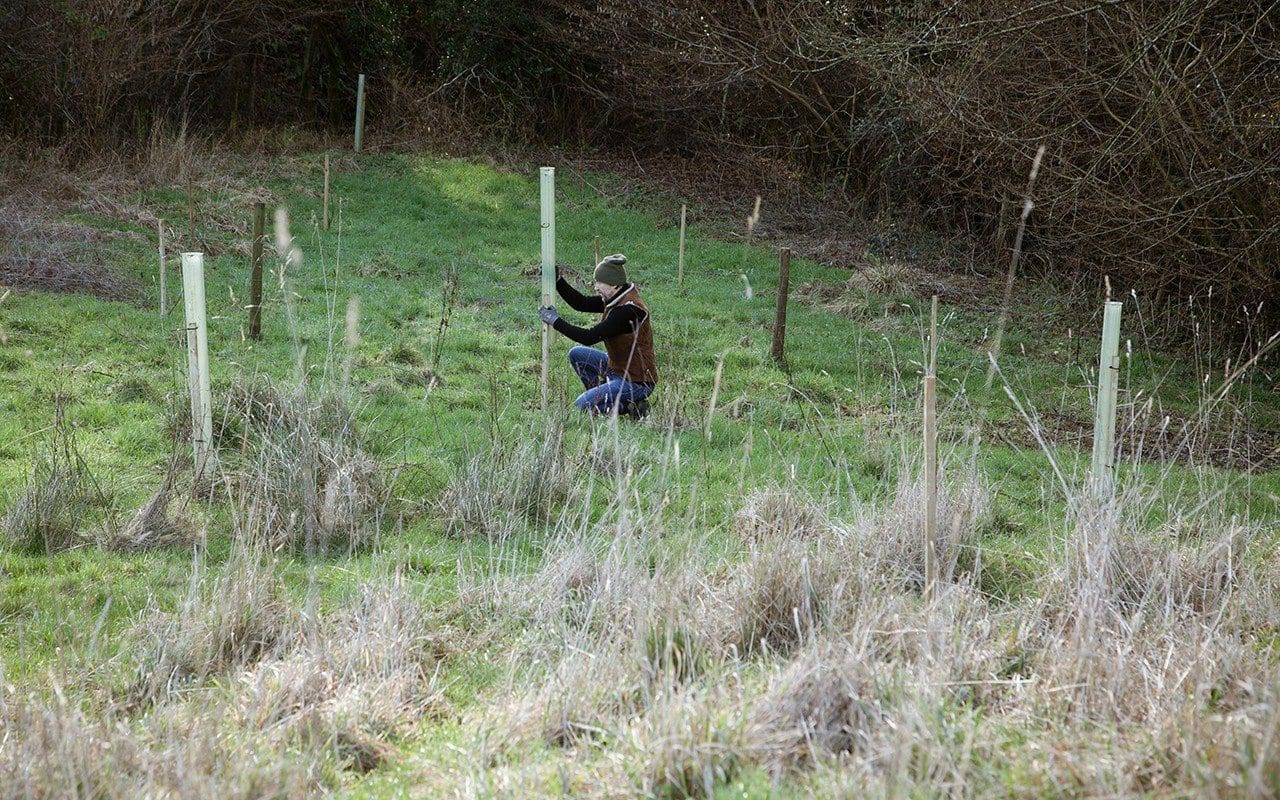 Dan putting tree guards on the newly planted coppice of hazel and sweet chestnut
For the last five years I have been slowly extending a new coppice in the hollow where the field dips away too steeply to the stream edge for haymaking. Thirty trees a year now sees the beginnings of something. Oak, to form a high canopy, and hornbeam and hazel, which will be put on a coppice rotation of twelve and eight to ten years respectively. This year I added some sweet chestnut to see if we can harvest our own poles for fencing in years to come. The coppice will provide the firewood I might be short of should the ash fail, and species variation within it will be good for ringing the changes in the ecology as we work from end to end over the course of a cycle.
It is a good feeling to this year have reached the end of the planted area and to be able to look back from the little whips which have just gone in to the progress mapped in year-on-year growth on the slopes beyond. This next chapter is begun.
Dan putting tree guards on the newly planted coppice of hazel and sweet chestnut
For the last five years I have been slowly extending a new coppice in the hollow where the field dips away too steeply to the stream edge for haymaking. Thirty trees a year now sees the beginnings of something. Oak, to form a high canopy, and hornbeam and hazel, which will be put on a coppice rotation of twelve and eight to ten years respectively. This year I added some sweet chestnut to see if we can harvest our own poles for fencing in years to come. The coppice will provide the firewood I might be short of should the ash fail, and species variation within it will be good for ringing the changes in the ecology as we work from end to end over the course of a cycle.
It is a good feeling to this year have reached the end of the planted area and to be able to look back from the little whips which have just gone in to the progress mapped in year-on-year growth on the slopes beyond. This next chapter is begun.
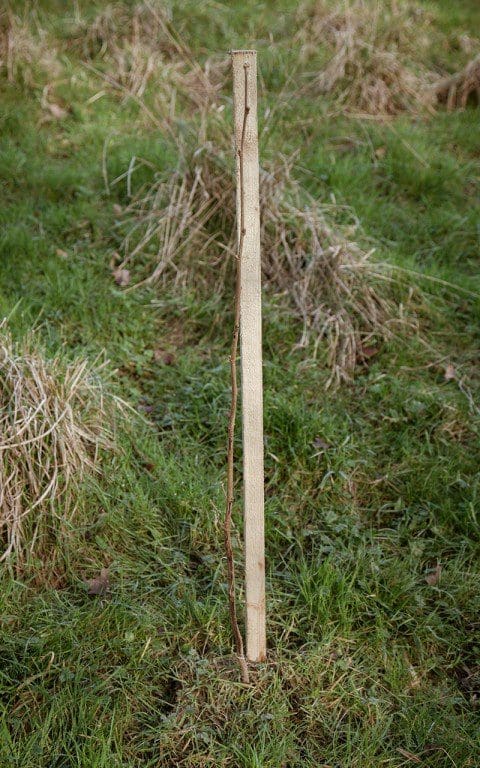 Words: Dan Pearson / Photographs: Huw Morgan
Published 19 January 2019 Winter is a productive season here in Britain. The weather rarely closes in to stop us for more than a few days and, with the garden in stasis, there is room to think and plan and do. The few truly dormant weeks saw us clearing another fallen tree in January, logging the wood for the winter and stacking the brush into piles (main image) that will become home to the creatures, lichens and fungi that like the protection and decay. If we have snow the tracks to and from the stacks advertise their occupancy but, where the surrounding grass gives way to the shelter within, there are already signs of the annual cleavers that climb into their cages and clothe them in summer.
Before the hedges were cut we harvested a few bundles of hazel to provide twiggy support for broad beans and sturdy poles for the sweet peas and climbing beans. They are a welcome bounty and the result of cutting the hedges every other year to allow them time to flower and berry. Two years is just enough time for the oldest and strongest hazel in the hedge to push out a good length of twiggery. Next year, whilst the hedges are growing back, I will coppice a couple of our freestanding hazel. It is hugely gratifying to be self-sufficient for plant supports for the garden. Whilst they are regenerating the hazel stumps are protected from the nibbling of deer with woven cages of offcuts.
Words: Dan Pearson / Photographs: Huw Morgan
Published 19 January 2019 Winter is a productive season here in Britain. The weather rarely closes in to stop us for more than a few days and, with the garden in stasis, there is room to think and plan and do. The few truly dormant weeks saw us clearing another fallen tree in January, logging the wood for the winter and stacking the brush into piles (main image) that will become home to the creatures, lichens and fungi that like the protection and decay. If we have snow the tracks to and from the stacks advertise their occupancy but, where the surrounding grass gives way to the shelter within, there are already signs of the annual cleavers that climb into their cages and clothe them in summer.
Before the hedges were cut we harvested a few bundles of hazel to provide twiggy support for broad beans and sturdy poles for the sweet peas and climbing beans. They are a welcome bounty and the result of cutting the hedges every other year to allow them time to flower and berry. Two years is just enough time for the oldest and strongest hazel in the hedge to push out a good length of twiggery. Next year, whilst the hedges are growing back, I will coppice a couple of our freestanding hazel. It is hugely gratifying to be self-sufficient for plant supports for the garden. Whilst they are regenerating the hazel stumps are protected from the nibbling of deer with woven cages of offcuts.
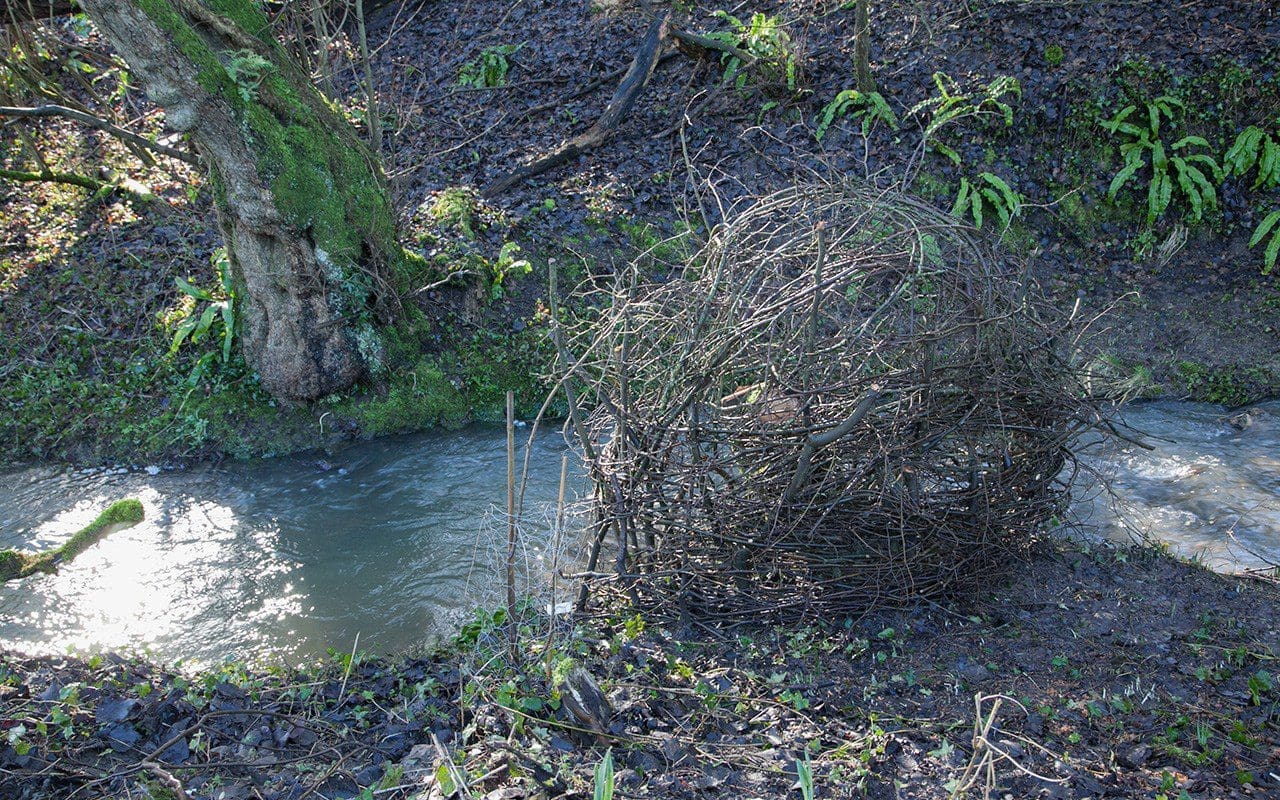 A coppiced hazel protected from deer by a cage of offcuts
A coppiced hazel protected from deer by a cage of offcuts
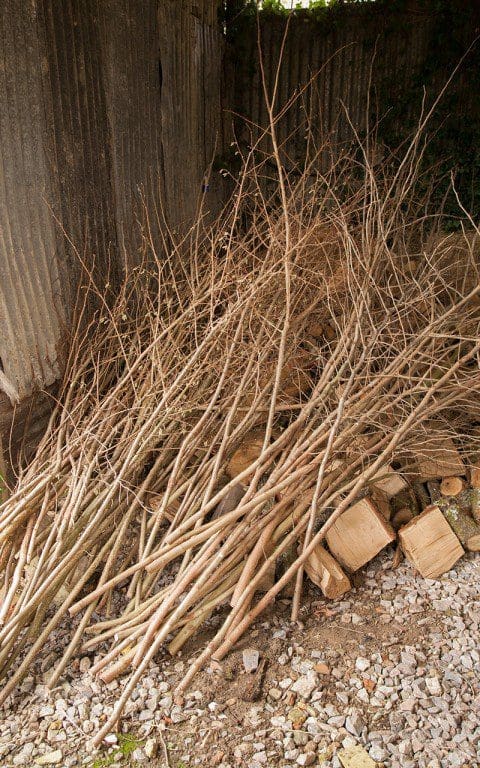 Hazel poles harvested from the hedgerows
Though we complain here about the winter’s duration, I cannot help but compare these few fairly benign months to the harsh conditions at my project in Hokkaido. There the gardeners have to leave the frozen landscape in search of work whilst the garden lies beneath deep snow until late April. The rush of tasks to either side – in preparation for the slumber and then the great surge of activity in spring – is palpable in head gardener Midori’s communications. Meanwhile, here we are free to dig and prune and plant. What luxury it is to get things in order with these few weeks of down time on our hands.
Hazel poles harvested from the hedgerows
Though we complain here about the winter’s duration, I cannot help but compare these few fairly benign months to the harsh conditions at my project in Hokkaido. There the gardeners have to leave the frozen landscape in search of work whilst the garden lies beneath deep snow until late April. The rush of tasks to either side – in preparation for the slumber and then the great surge of activity in spring – is palpable in head gardener Midori’s communications. Meanwhile, here we are free to dig and prune and plant. What luxury it is to get things in order with these few weeks of down time on our hands.
 The Meadow Garden at the Tokachi Millennium Forest in Hokkaido is under snow until late April. Photograph: Syogo Oizumi
It has been a busy winter for I am readying myself to plant up the first sections of the new garden that was landscaped last summer. This time last year the same ground lay fallow with a green manure crop protecting it from the leaching effect of rain and to keep it ‘clean’ from the cold season weeds that colonise whenever there is a window of growing opportunity. The winter rye grew thick and lush, except where the diggers had tracked over the ground during the previous summer’s building works, where it grew sickly and thinly, indicating that something needed addressing before going any further.
When we started the winter dig, the problem that the rye had mapped became clear. Not far beneath the surface the soil had become anaerobic, starved of air by the compaction and with the tell-tale foetid smell as you turned it. The organic matter in the soil had turned grey where the bacteria were unable to function without oxygen and the water ran off and not through as it should. Turned roughly at the front end of winter, like a ploughed field, the frost has since teased and broken this layer down and the air has made its way back into the topsoil to keep it alive and functioning. Though it is still too wet to walk across, you can see that the winter freeze and thaw has worked its magic and that, as soon as we have a dry spell, it will knock out nicely like a good crumble mix, in readiness for planting.
The Meadow Garden at the Tokachi Millennium Forest in Hokkaido is under snow until late April. Photograph: Syogo Oizumi
It has been a busy winter for I am readying myself to plant up the first sections of the new garden that was landscaped last summer. This time last year the same ground lay fallow with a green manure crop protecting it from the leaching effect of rain and to keep it ‘clean’ from the cold season weeds that colonise whenever there is a window of growing opportunity. The winter rye grew thick and lush, except where the diggers had tracked over the ground during the previous summer’s building works, where it grew sickly and thinly, indicating that something needed addressing before going any further.
When we started the winter dig, the problem that the rye had mapped became clear. Not far beneath the surface the soil had become anaerobic, starved of air by the compaction and with the tell-tale foetid smell as you turned it. The organic matter in the soil had turned grey where the bacteria were unable to function without oxygen and the water ran off and not through as it should. Turned roughly at the front end of winter, like a ploughed field, the frost has since teased and broken this layer down and the air has made its way back into the topsoil to keep it alive and functioning. Though it is still too wet to walk across, you can see that the winter freeze and thaw has worked its magic and that, as soon as we have a dry spell, it will knock out nicely like a good crumble mix, in readiness for planting.
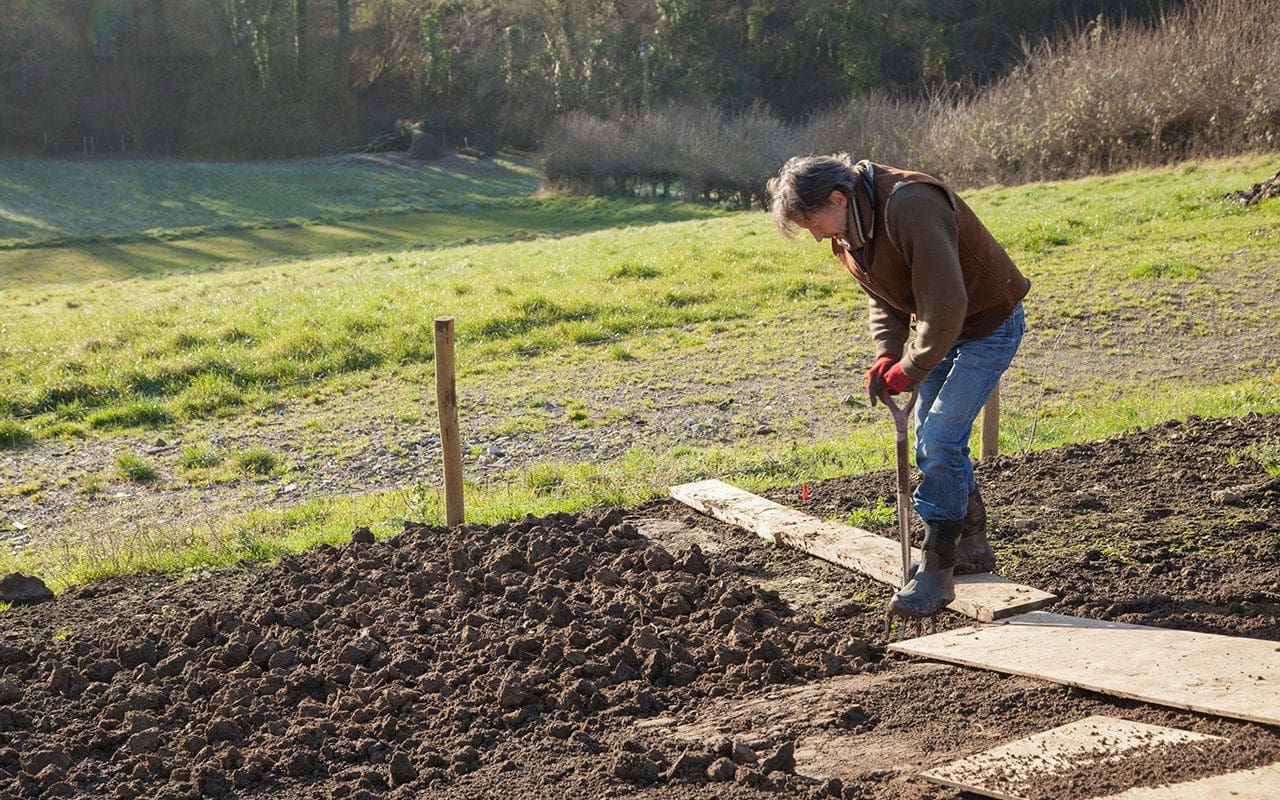 Digging over the compacted soil, working from boards to prevent further compaction
Time taken in preparation is never time wasted and it is a good feeling to give new plants the best possible start in their new positions. As the soil was previously pasture and we have the advantage of heartiness, the organic content is already good enough, so we will not be digging in compost this year. I want the plants to grow lean and strong so that they can cope with the openness and exposure of the site rather than be overly cosseted or encouraged to grow too fast and fleshy. Organic matter will slowly be introduced after planting in the form of a weed-free compost mulch to keep the germinating weeds down and to protect the soil from desiccation. The earthworms, which are now free to travel through the previously compacted ground, will pull the mulch into the soil and do the work for me.
Digging over the compacted soil, working from boards to prevent further compaction
Time taken in preparation is never time wasted and it is a good feeling to give new plants the best possible start in their new positions. As the soil was previously pasture and we have the advantage of heartiness, the organic content is already good enough, so we will not be digging in compost this year. I want the plants to grow lean and strong so that they can cope with the openness and exposure of the site rather than be overly cosseted or encouraged to grow too fast and fleshy. Organic matter will slowly be introduced after planting in the form of a weed-free compost mulch to keep the germinating weeds down and to protect the soil from desiccation. The earthworms, which are now free to travel through the previously compacted ground, will pull the mulch into the soil and do the work for me.
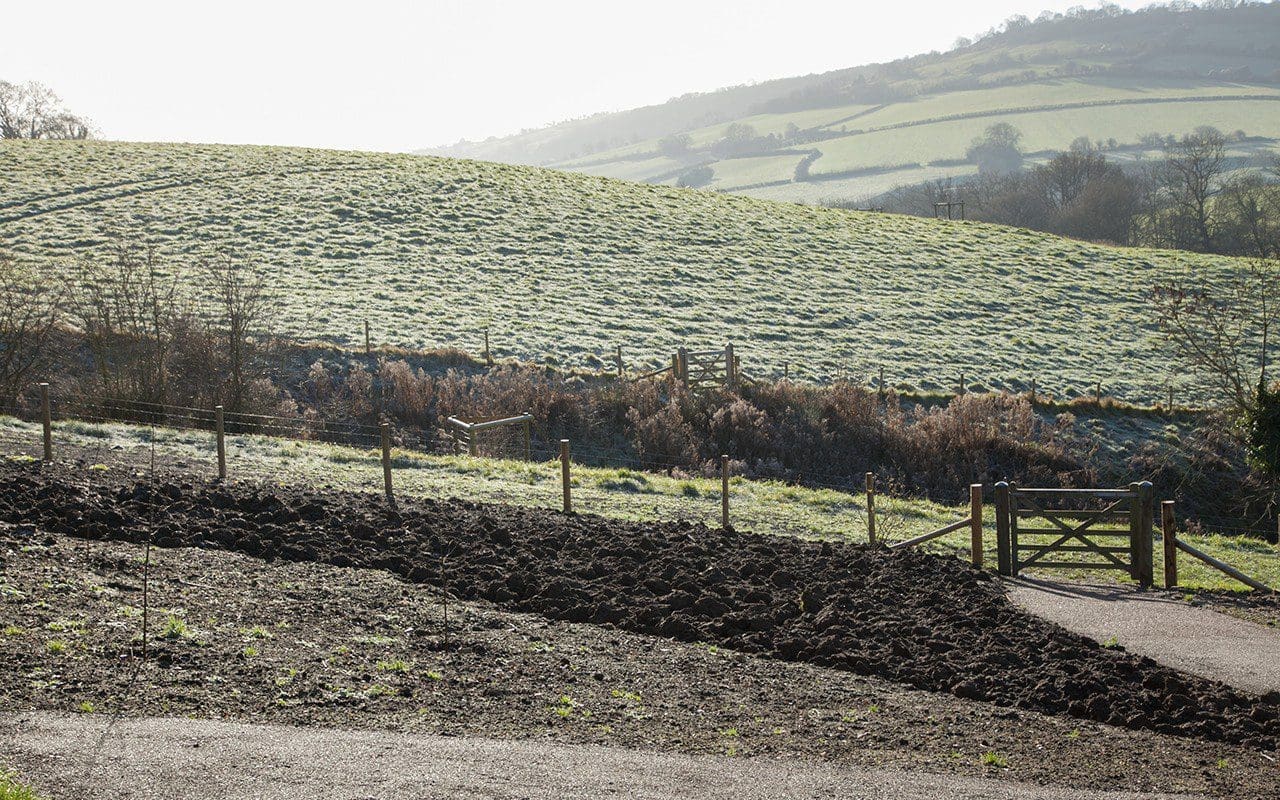 One of the planting beds in the new garden half dug over to allow the frost to do its work
In the vegetable beds, where we have been working the soil and demanding more from it, the organic matter is replenished annually to keep the fertility levels up. Our own home made compost is dug in now that the heaps are up and running. The compost is left a whole year to break down so that one bay is quietly rotting whilst the other is being filled. If I had more time, or a forklift to turn it, I would have a better, more friable compost in just six months. Turning allows air into the heap and the uncomposted material moved to the centre heats the heap more efficiently to help to kill weed seeds.
One of the planting beds in the new garden half dug over to allow the frost to do its work
In the vegetable beds, where we have been working the soil and demanding more from it, the organic matter is replenished annually to keep the fertility levels up. Our own home made compost is dug in now that the heaps are up and running. The compost is left a whole year to break down so that one bay is quietly rotting whilst the other is being filled. If I had more time, or a forklift to turn it, I would have a better, more friable compost in just six months. Turning allows air into the heap and the uncomposted material moved to the centre heats the heap more efficiently to help to kill weed seeds.
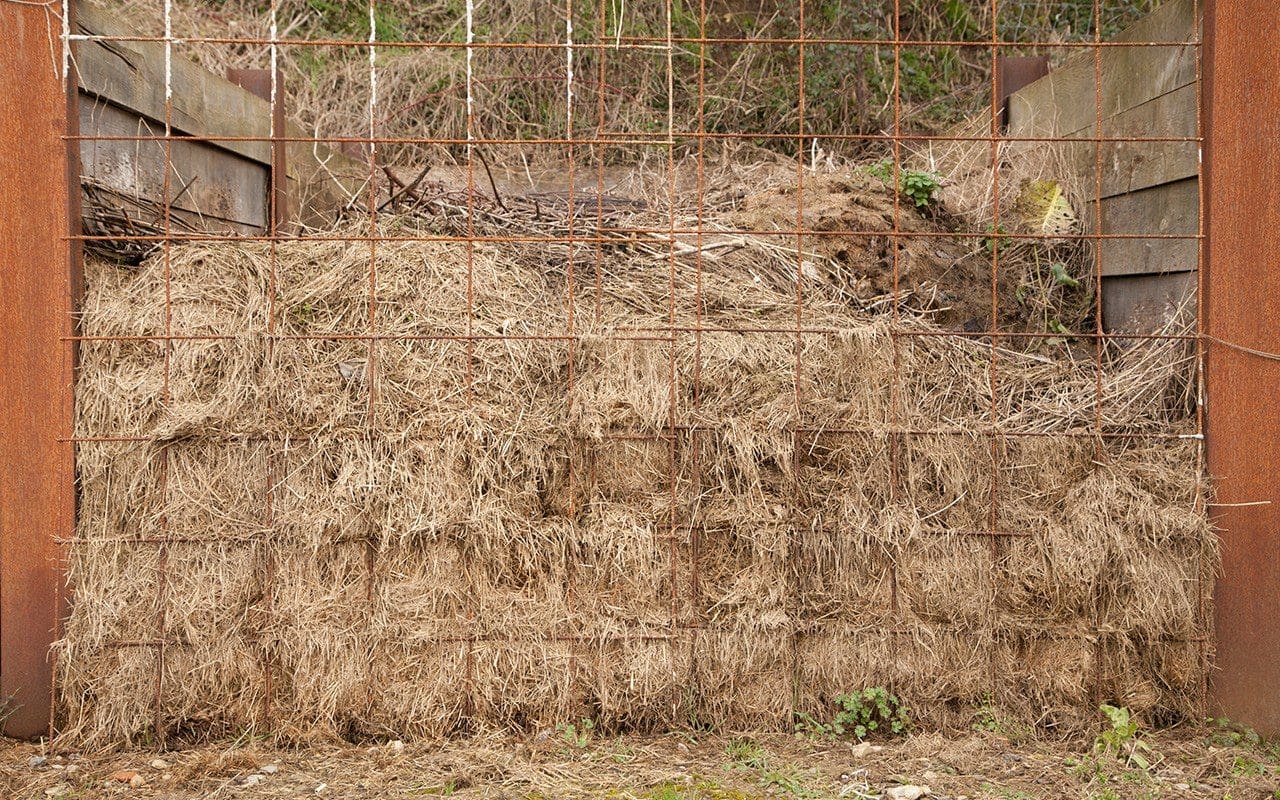 One of the compost bays
My year old compost is only really good for turning in as it springs a fine crop of seedlings from the hay we rake off the banks in the summer. There are also rashes of garden plants; euphorbias that were thrown on the heap after their heads were cut in seed, bronze fennel, Shirley poppies, phacelia and a host of other plants that have lain dormant. No matter. Since the heaps sit directly on the earth the compost is full of worms, and this can only be good for the soil and its future aeration. You can see the soil in the garden getting better and darker, more friable and more retentive with every year that passes. A reward for the hard work and payback for the bounty that we take from it.
Words: Dan Pearson / Photographs: Huw Morgan We are sorry but the page you are looking
for does not exist.
You could return to the homepage
One of the compost bays
My year old compost is only really good for turning in as it springs a fine crop of seedlings from the hay we rake off the banks in the summer. There are also rashes of garden plants; euphorbias that were thrown on the heap after their heads were cut in seed, bronze fennel, Shirley poppies, phacelia and a host of other plants that have lain dormant. No matter. Since the heaps sit directly on the earth the compost is full of worms, and this can only be good for the soil and its future aeration. You can see the soil in the garden getting better and darker, more friable and more retentive with every year that passes. A reward for the hard work and payback for the bounty that we take from it.
Words: Dan Pearson / Photographs: Huw Morgan We are sorry but the page you are looking
for does not exist.
You could return to the homepage